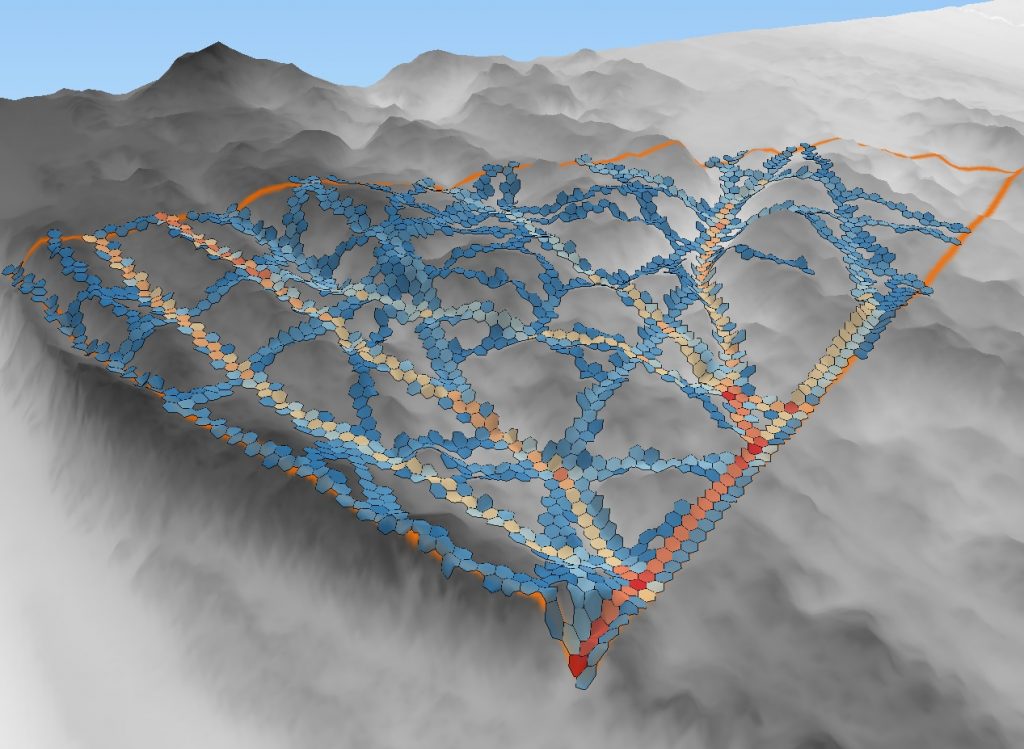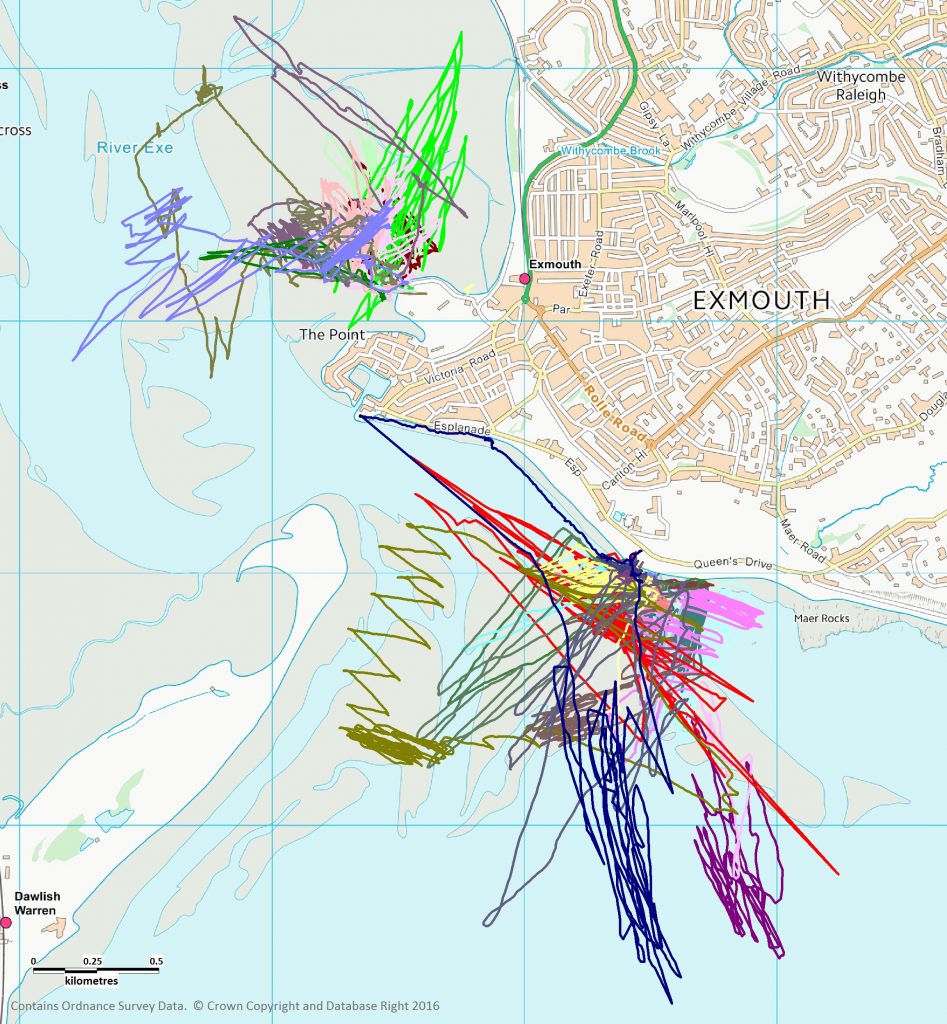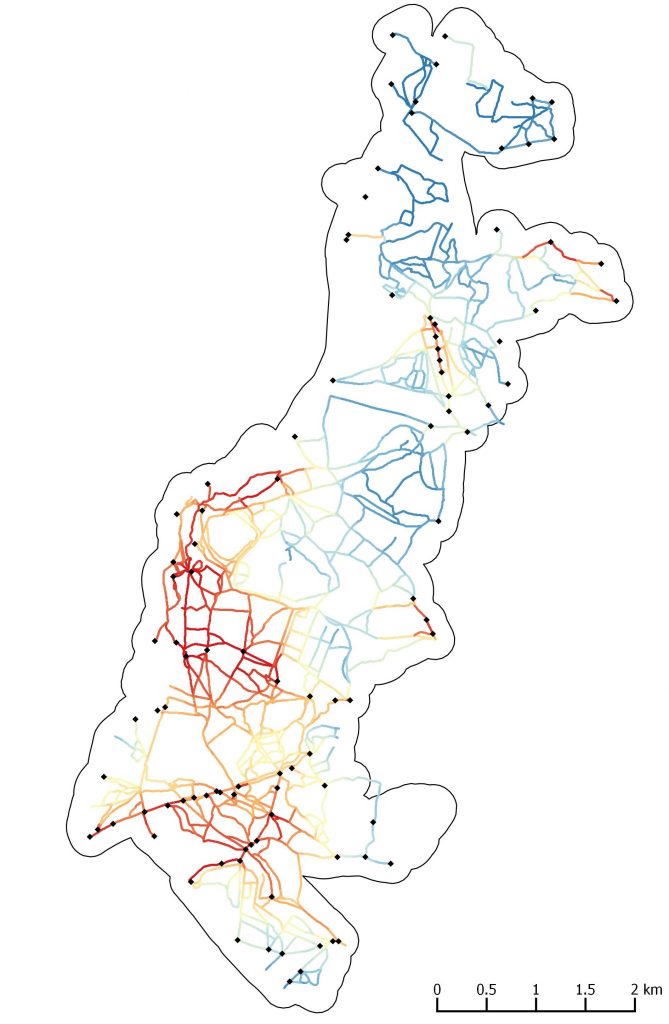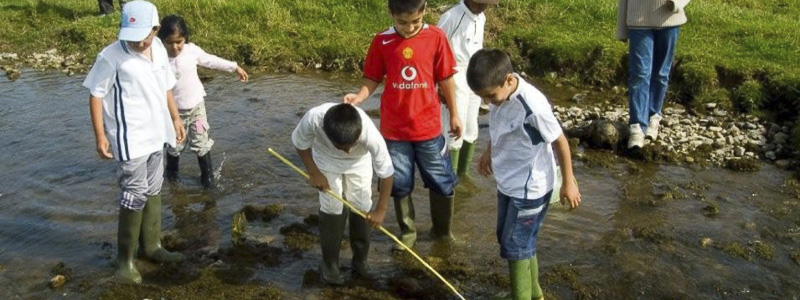By Chris Panter & Durwyn Liley - Footprint Ecology
(in Volume 27)
Introduction
Where people go within sites is fundamental to understanding access patterns and informing visitor management. Information on routes taken can reveal which parts of sites are most visited, which paths are most used, how far people go and how different types of visitor behave. However such data can be difficult to collect and a range of relatively hi-tech options are available. Working in a consultancy that does a wide range of visitor surveys we draw from our experience and compare seven different approaches to show visitor distribution within sites. We list some notable examples of the methodologies, but rather than a comprehensive review, our aim is to summarise the range of options and discuss of the pros and cons of each. Individual methodologies differ greatly and the specific project aims will dictate the approach required. The seven broad approaches we consider are:
- Fixed Point Counts: counts for the number of people passing a set location
- Direct observation: mapped footfall of where people walk from fixed vantage points
- Time lapse photography/CCTV: Photography provides single counts over a wider area / CCTV can provide mapped footfall
- Transects: counting number of people encountered along a set route
- GPS tracks: individual routes of people mapped from the GPS units given directly to people
- Interview transcription: individual routes drawn lines on maps through interviewing people
- Crowd sourced/App data: this can include a range of data – most commonly individual routes from GPS tracks of smart devices
Approaches
Fixed Point Counts
These count methods can be are used to obtain accurate numbers of people entering or passing particular points at sites. Various simple methods can be used, such as, direct surveyor counts, machine counts (e.g. car-park ticket sales) and automated counters (e.g. camera traps, beam counters, pressure pads, heat sensitive devices). Providing comparable data are collected across a site (for example a network of count data from site entrances or path junctions) the data can show relative levels of use. Examples include Dolman et al (2008)[i] who positioned surveyors across 983 path sections within Breckland in Norfolk or the Dorset Heaths where a network of up to 60 automated counters provide comparable data across different heaths over several years ([ii]Panter & Liley 2015). The data obtained is very basic and on large or complex sites count data from many locations are required to give a good indication of the spatial pattern of use, and this can be difficult to achieve.
Direct observation
Direct observation is essentially an extension of the fixed point counts, applied to a wide area rather than a single point. This involves recording visitor distribution and mapping the distribution of people within a predetermined study area. With a good vantage point and good sight lines it is possible to count and map people over a wide area. By recording over an extended period it is possible to record the individual’s routes through the recording area to examine where footfall is (e.g. Figure 1). Important additional information can also be recorded such as the length of time present, behaviour etc. All visitors during a survey period are recorded (without any sampling bias), and combined with the controlled survey methodology it ensures any estimates of footfall are highly accurate. However the quality of the data are dependent on how easy it is to view an area and observe recreational access. At very busy sites it can be very hard to maintain a record of all individuals’ movements. Conversely, where there is a low frequency of access or sporadic visitor patterns then considerable survey effort is likely to be required to collect adequate data. It is also possible that the presence of surveyor modifies people’s behaviour

Figure 1: Example of a 3-D map of footfall density, calculated from direct observation in an undulating dune system (Footprint Eology in-prep). Using a regular grid the density of footfall was calculated based on observed routes from a vantage point on the dunes. Blue cells have low footfall density, while red cells have high density. Clear use of paths are visible and inform small-scale site management
Time Lapse Photographs/CCTV
Cameras when mounted at key vantage points can provide repeat images or video footage, providing similar data to the data from direct observation. Cameras mounted at fixed locations are limited by the view and quality of the vantage point, and may be difficult to install in open countryside, as such they are perhaps more suited to urban areas. Images of people are covered by the Data Protection Act 1998 and cameras must be used responsibly with proper safeguards in place. We have used time lapse photographs from viewpoints over estuaries to record how often people are present in particular areas and what activities they were conducting (Fearnley et al. 2013)[iii].
Transects
Transects can be undertaken on foot, by vehicle or even using drones or aircraft, for example Tratalos et al. (2005)[iv] plotted visitor distribution along the whole East Anglian coast from a light aircraft. Our experience with images from drone flights is that people are easiest to pick out when strong shadows are present. Transects are similar to the fixed counts but extend the counts across a wider area and can involve recording people within set distances or radius – as commonly used for assessing butterflies and other invertebrates ([v]Sutherland 1996). As such transects can work better than fixed counts where visibility is limited or patchy.
GPS units
GPS units can be handed out to visitors and collected at the end of a walk/visit. Low cost GPS units are available that can be clipped to bags or worn on a lanyard and are becoming increasingly common in visitor studies (Hallo et al. 2012)[vi] and can be used on dogs. GPS units provide detailed route information (e.g. Figure 2) and also record speed and time spent at particular areas. GPS can help record routes for specific user groups which are otherwise hard to track and record (e.g. cycling, kite surfing, boating). Concerns with the approach relate to the challenges of gaining random samples of users. Only those people who consent to carry units and can return the units can be included. Furthermore, users may modify their behaviour as a result of carrying a unit. The approach requires a large number of units to be handed out by surveyors and collected in again and this can be complex to organise. As the presence of a surveyor is necessary it is possible to combine the route data with other visitor specific information collected through interviews, such as profile etc.

Figure 2: GPS tracks from kite surfers on the Exe Estuary (Liley et al. 2011). Data collected by handing out GPS units. Thirty six routes shown, collected on 11 different dates (all autumn or winter) during 2009 – 2011. Colours represent different tracks
Interview transcription
Route data can be collected by simply asking people where they have been and recording the information on a paper or digital maps. This information is best obtained from face to face interviews, providing the opportunity for surveyors to transcribe routes, check through questioning and help interviewees interpret maps. The surveyor is able to ensure a random sample of visitors using the site are interviewed to maintain data quality. Data are best collected at the end of people’s visit rather than at the start or part-way through. To complete these interviews requires useable maps of the site and of the path network. Some visitors can struggle with map reading/ knowing their location and there is the potential for visitors to under/overestimate where they have been or falsify their responses. As a surveyor is present it is possible to gain added value by collecting other visitor specific information through interviews, such as profile etc.
Crowd sourced/App data
Increasingly data collected from individuals using smart technology is being used in ‘citizen science’ projects and can provide a wealth of data. Using the inbuilt GPS in smart devices, visitors to sites are able to use technology to record their visit on particular preloaded apps. The approach is appealing in that large datasets may be possible without survey work needed, but as a random sample is extremely difficult to achieve, results may be questionable. Apps are often focused to particular user groups or devices and software has to be preinstalled (i.e. visitors have to be contacted prior to their visit).
Conclusion
Of the different methodologies assessed there are clearly both advantages and disadvantages to individual approaches and arguably certain circumstances in which approaches are more suited. Key advantages and disadvantages of the different approaches are summarised in Table 1

Direct observation, fixed counts and transects on the whole can provide accurate count data, and are useful when numbers of visitors is a key aim of a survey. The use of direct observation works well on open sites with good vantage points (e.g. open coastal/grassland locations) or for studying impacts on small areas on sites with particular access issues over site features (e.g. studying disturbance/trampling effects).At moderate spatial scales (e.g. an individual site or complex of sites), interview transcription of routes or handing on GPS units is perhaps more applicable. GPS units can only be given out to those visitors who are returning to the start point and visitors have to be intercepted at the start and end of their visit. For sites with relatively few access points or where a high level of accuracy on route data in required then GPS units are recommended. Otherwise the routes can often be as easily recorded on paper or digital maps with the visitors. Both route transcriptions and GPS units can be included as a component in a face-face visitor survey and can therefore be linked to visitor profiles and other data.Crowd sourced data from apps provides quick access to a huge amount of data and pose a solution to how to obtain information on routes. However there are some concerns regarding its applicability for example the challenge in ensuring an un-biased sample of users, given variations in smartphone ownership and likelihood of visitors having particular apps installed. Crowd-sourced data is unlikely to be effective for example in deriving accurate estimates of footfall along a particular path. The app data is particular useful when interest is solely focused to particular user groups which can be otherwise hard to record routes from interviews or observations (e.g. mountain bikers or windsurfers).Use in modellingWhere data has been collected systematically it is possible to use the data to scale up visitor data and model the spatial distribution of people. Modelling approaches work well at regional scales where the logistics of monitoring over such a large area would be difficult. Consideration of the potential for generating such models is an important consideration in survey design. From a relatively small amount of the data on visitor numbers, routes and behaviour data can be modelled to provide an overall strategic assessment of the visitor levels. Models of the visitor access on sites is most applicable at large sites with many access points, a complex of sites, or even regional scales. Models require some basic information on the visitor numbers at a sample of access points and details of all the access points.

Figure 3: Examples of visior models showing predicted relative number of visitors in a large complex of heathland sites (Footprint Ecology, in-prep). Black dots show the many access points into the site and at each of these the daily number of visitors is calculated. Models were used to estimate even flows of the visitos into the known path network to provide density estimates at each 5 x 5m cell of footfall. Blue areas indicate low predicated footall and red area high predicted footfall
References[i] Dolman, P., Lake, I.R. & Bertoncelj, I. (2008) Visitor Flow Rate and Recreational Modelling in Breckland. UEA, Norwich.[ii] Panter, C. & Liley, D. (2015) Urban Heaths Partnership: Monitoring Report for 2014-15. Footprint Ecology/Urban Heaths Partnership.[iii] Fearnley, H.,Cruickshanks,K.,lake,S.& Liley, D. (2013) The Effects of Bait Harvesting on Bird Distribution and Foraging in Poole Harbour SPA (89). Footprint Ecology/Natural England
[iv] Tratalos, J.A., Gill, J.A., Bateman, I., Watkinson, A.R. & Sutherland, W.J. (2005) Interactions between Tourism, Breeding Birds and Climate Change across a Regional Scale. Tyndall Centre for Climate Change Research, Norwich.[v] Sutherland, W.J. (1996) Ecological Census Techniques. Cambridge University Press, Cambridge
[vi] Hallo, J.C., Beeco, J.A., Goetcheus, C., McGee, J., McGehee, N.G. & Norman, W.C. (2012) GPS as a Method for Assessing Spatial and Temporal Use Distributions of Nature-Based Tourists. Journal of Travel Research, 51, 591–606.
